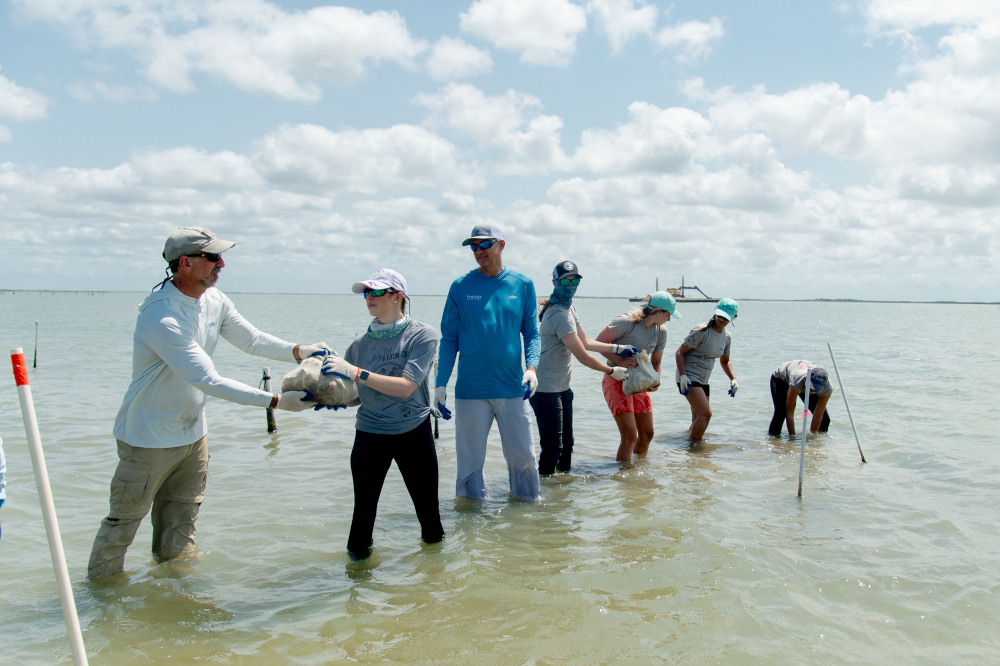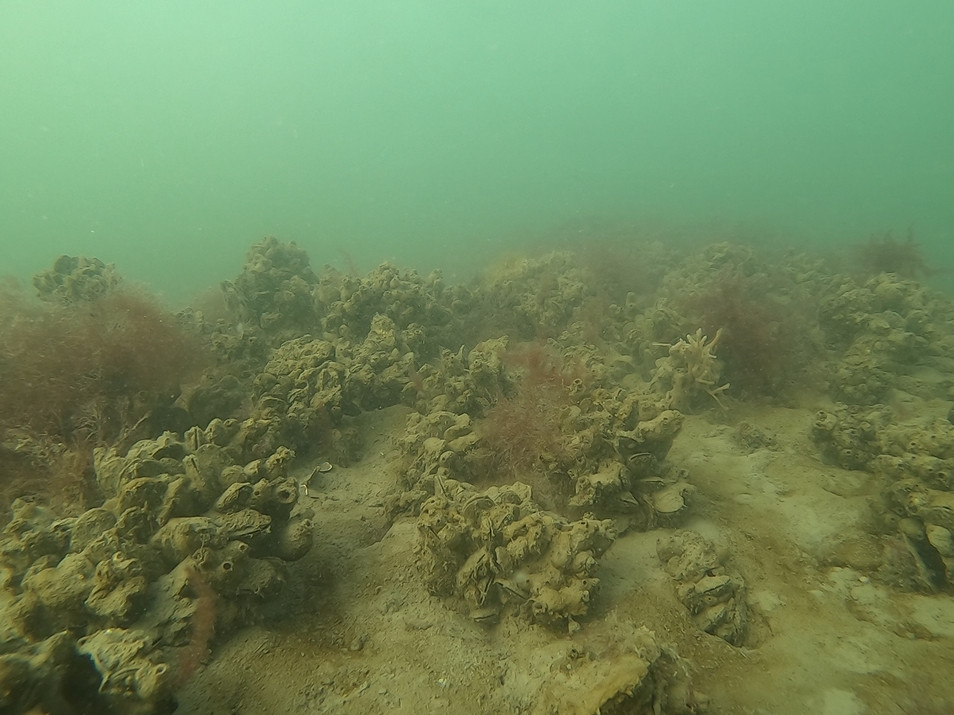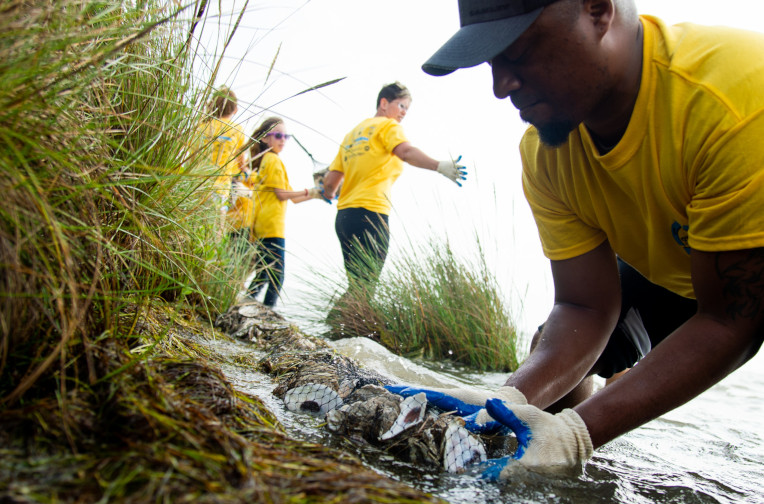As oyster reefs have declined, other marine species have suffered and coastal storm damage has increased. Innovative programs are starting to help.l
Coastal ecosystems — including oyster reefs, sandy beaches, mangrove forests and seagrass beds — provide important habitat for marine life and food and recreation for people. They also protect shorelines from waves and storms. But these precious systems face serious threats. This series looks at what put them at risk, along with examples of efforts to restore and protect important coastal ecosystems around the world.
At the Water Street Market oyster bar in Corpus Christi, Texas, the popular morsels arrive in typical fashion, nestled in open shells spiraled atop an ice-filled tray around containers of red sauce and horseradish.
What happens afterward isn’t typical: The shells go back into nearby bays to help restore oyster reefs.
Since the 1800s populations of the eastern oyster (Crassostrea virginica) have declined dramatically along the U.S. Atlantic and Gulf coasts due to overharvesting, pollution and disease. Other species and populations have suffered similar drops. Worldwide, scientists estimate at least 85% of oyster reefs have disappeared.
The loss doesn’t affect just diners. Oysters are ecosystem engineers that create extensive reefs that protect shorelines from storm surges and erosion and provide important habitat for fish, crabs and other marine species.
Oysters also maintain water quality, with each one capable of filtering nearly 16 gallons (60 liters) of water a day.
Fewer oysters mean coastal communities see fewer of these benefits. Declining numbers also make it harder for oysters to naturally replenish reefs without some help.
Save the Shells
Oysters spawn by releasing sperm and eggs into the water. The resulting larvae swim freely for about three weeks and then permanently attach to a surface, when they become known as spat. Within a few years, spat grow into mature oysters, complete with their own shell. While larvae will settle on anything hard, they prefer the shells of other oysters.
These days finding them has become a challenge.
Up until the 1980s in Texas, tons of oyster shells were dredged from reefs and used as material to create roads (albeit somewhat rough ones) all along the coast. And while the state’s commercial oyster harvest has declined drastically, and has seen partial closures in recent years, the Gulf region (which includes three other states) still produces 45% of the nation’s catch — about 12.5 million pounds of meat, according to NOAA. That’s a lot of oyster shells that came out of the water, most of which end up in landfills.
To change that, the Harte Research Institute for Gulf of Mexico Studies at Texas A&M University-Corpus Christi started the Sink Your Shucks program in 2009. So far it has put 3 million pounds of shells back into the ocean where oyster larvae can find them. The efforts have helped restore more than 45 acres of reefs in nearby Copano, Aransas and St. Charles Bays.
Restaurants separate shells into special rolling bins that staff from Sink Your Shucks collect on a regular basis. The shells are then piled up at the Port of Corpus Christi to sanitize in the sun for about six months before they are taken to a restoration site. They may be placed on a rock base to keep them from sinking into the mud or just poured into the water, depending on the condition of the sea bottom.
Some are put in mesh bags, which keeps the shells from spreading out and being covered in sediment and gives vertical structure to the reef. Scientists with HRI’s Coastal Conservation and Restoration Lab tested different bag materials, including plastic and biodegradable jute, cotton, and cellulose.

A line of volunteers carry bags of oyster shells into the water. Courtesy Texas A&M University-Corpus Christi
The study showed the oysters and other marine life are perfectly happy with the biodegradable material, and the project is using cotton.
“There are issues with cost and sourcing,” says project manager Natasha Breaux. “Plastic is cheap. But the rationale was that it would be better to use something biodegradable and not introduce plastics into the ocean.”
Restaurants sign up, says program coordinator Mike Osier, because keeping shells out of the landfill saves them money and they can highlight their commitment to sustainability.
Both facts motivated Water Street owner Brad Lomax, who helped establish the program. He recalls complaining to a customer, who happened to be a scientist from HRI, about high dumpster charges caused by oyster shells.
“He said oyster shells in a landfill are a resource out of place,” Lomax says. “That really resonated with me. When you dredge an oyster reef, you essentially destroy it for a significant period of time. We can’t do that anymore.”
Osier strives to make participating as easy as possible and promotes restaurants on the program website and social media. He provides an annual statement of the total pounds donated and the current market rate for shell for businesses to use in claiming a tax benefit.
Once the shells are placed, the Coastal Conservation and Restoration lab monitors restoration sites.
“It’s like a reef snapshot,” says researcher Danielle Downey. “We count and measure oysters in the field. We put shells out in sample trays and later collect the animals growing there and bring them back to the lab to look at abundance and diversity. We get a lot of toadfish, shrimp and crabs — lots of crabs.”
Larvae Wanted
Texas still has enough natural reefs to produce the baby oysters needed to populate restoration projects, but the oyster population in the Chesapeake Bay sits at about 1% of historical levels due to centuries of overharvesting — about 1.5 billion oysters a year by the end of the 19th century — along with pollution and habitat destruction. Protected areas established in 2010 cover about 24% of all oysters in Maryland, but with such a low wild population, protection alone is not enough.
“The reefs won’t come back on their own — it takes active restoration to jumpstart the population,” says Matt Ogburn, head of the fisheries conservation lab at the Smithsonian Environmental Research Center.
In the Chesapeake that jumpstart includes an approach called spat on shell: growing larvae in a hatchery, letting them settle on shells, then placing those on a reef. The process is complicated by the fact that these mollusks switch sexes, often multiple times during their lives, but it works. In 2021, for example, the Chesapeake Bay Foundation deployed more than 21 million spat on shell to reefs throughout the Bay. As part of the Chesapeake Oyster Alliance, some 100 nonprofits, community organizations, and oyster growers, CBF is contributing toward an overall goal of 10 billion.

A 10-year old restoration reef in Harris Creek, a tributary of the Choptank River directly across Chesapeake Bay. Courtesy Smithsonian Environmental Research Center.
CBF has been restoring oyster reefs in the Bay since 1996. In 2022 it partnered with SERC, moving its spat-on-shell operation to the center’s campus in Edgewater, Maryland. One of SERC’s roles is to conduct extensive monitoring at sites before and at regular intervals after restoration. The team collects data aimed at creating a complete picture of what happens in the first few years, says Ogburn.
“We use high-frequency sonar to see how tall and complex reefs are, the abundance and size of fish and crabs around the reef, and how that differs as the reefs grow and mature,” he says. “Because sonar cannot identify specific species, we extract DNA from water samples, sequence it, and compare results to a reference library for the Chesapeake Bay. We also take underwater video every year and use a scoring system to rank the size and height of reefs. Combining all these methods provides an unprecedented picture of how a restored reef develops.”
The lab currently monitors three restoration sites and unrestored control sites that have similar conditions. The early news has been good, Ogburn says, with oysters surviving and increasing in abundance.
“We’ll keep collecting data for two more years, then review those results and provide information on how restoration is working or whether we need to modify our efforts going forward,” he says, adding that so far, the reefs in the best condition have both protection and active restoration.
Bringing back the Bay’s oysters is a big task that takes a lot of hands. In addition to SERC’s research and monitoring, CBF helped design the sites and monitors settlement of larvae, including any natural recruitment of baby oysters. Arundel Rivers Federation’s Riverkeeper monitors the water quality around restored reefs. CBF and Northrop Grumman are monitoring the soundscape around reefs and how it changes over time.
CBF receives shells from The Oyster Recovery Partnership’s Shell Recycling Alliance, which collects them at restaurants in central Maryland, Washington DC, and northern Virginia and from dozens of public drop sites. CBF also runs its own program, Save Oyster Shells, that collects at restaurants, drop sites, and events in Maryland and Virginia. In fact, shell collection projects exist all along the Gulf and East coasts.
Collection efforts eventually could extend beyond coastal areas, says Osier, if obstacles such as shell storage and transportation can be overcome. When shells are not available, though, artificial substrate such as concrete and rock seems to work just fine.
These projects are proving that combining protection, substrate, and lab-grown spat where needed can create a recipe for successful oyster reef recovery. And it’s a recipe that seems to work fairly quickly, says HRI’s Breaux.
“Typically, restored reefs start to act like natural reefs in a short amount of time, within months.”
On Saturday May 4 and Saturday May 11, volunteers can join Sink Your Shucks at Goose Island State Park near Rockport, Texas, to bag oyster shells. Register for these and future events here.





